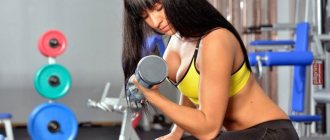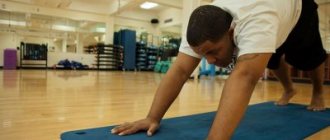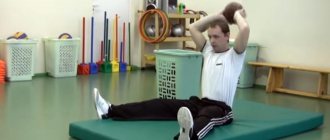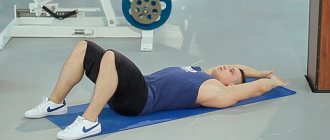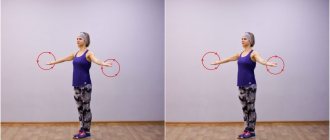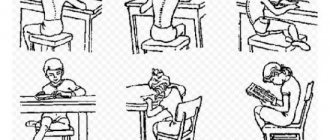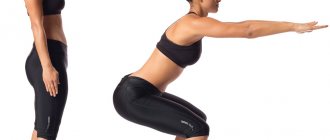Sport
- Basic rules for working with fitball
- Pilates exercises on fitball
- Twisting
- Reverse twist
- Bridge with a riffle
- Push-ups on the ball
- Lateral lift
Joseph Pilates created a unique system of exercises, which became a new type of exercise that supplanted other types of fitness. Pilates is an excellent way to improve health, accessible even to people with musculoskeletal problems. Pilates on a fitball is a type of exercise with a large gymnastic ball.
The use of a fitball is recommended even for pregnant and elderly people
What is Pilates with a gymnastic ball?
The principle is based on the alternation of dynamic and static loads performed under mental control. Pilates on the ball:
- strengthens the muscle armor;
- straightens the spinal column;
- comprehensively works the skeletal muscles;
- increases oxygen in peripheral blood;
- eliminates degenerative changes in joints.
Due to the eccentric contraction of the fibers under the influence of an external force exceeding the counteraction of the filamentous myofibrils, rigid shortened muscles lengthen and become elastic. By expanding the range of axial rotation of the joints, gait and movements become easier. At the same time, to stabilize the muscles of the pelvic floor, abs, and back, the body burns a lot of calories. Strength loading and stretching create beautiful shapes.
Benefits of doing Pilates exercises with a miniball
Research shows that if you perform traditional crunches with a Pilates ball under your lower back, your abdominal muscles will work more effectively by increasing your range of motion while providing excellent support to your back.
Now try this full Pilates mini-ball workout!
Isolation of the abdominal muscles occurs without increasing tension in the back muscles. With optimal use of such a ball, less trained participants in Pilates classes can make their program simpler, while advanced practitioners, on the contrary, can complicate their exercises with the same mini-ball.
Main rules
If you have not done Pilates with a ball before, it is better to work in a group when mastering the technique. You will be asked to study the basic principles of the system, built:
- on centering;
- conscious concentration;
- visualization;
- work at a slow pace.
The essence of the effective method is to work with measured breathing, controlled execution of each movement, systematically. Over time, you will learn to establish neuromuscular connections and feel the contraction of fibers at peak load.
What is Pilates: its features and differences
Pilates is a system of dynamic physical exercises developed by Joseph Pilates, aimed at working all muscle groups without putting stress on the spine.
The main difference between Pilates and yoga and such areas as stretching and callanetics is the reduction to zero injuries and all kinds of complications. The technique uses a specific breathing system, which massages the internal organs and increases the supply of oxygen.
Another difference is that the exercises are not static and are not aimed only at stretching them. The movements in Pilates make the muscles more elongated, that is, the muscles become stronger as they lengthen during the exercise. The deep muscles are included in the work, the muscle corset is strengthened.
In Pilates, the exercises are accompanied by diaphragmatic breathing (chest), while in yoga you need to breathe from the stomach.
But there are also similarities with yoga, since Pilates took as its basis the emphasis on the interaction of the mind and body, so now the technique belongs to the areas of “Body and mind” (“body and mind” or “intelligent body”). This principle is based on the correct execution of the exercise and awareness of the action.
In Pilates there are no large amplitudes; all attention is directed to stretching the muscles while contracting them.
How to choose a fitball
Sports brands supply an assortment of equipment. High-quality Swiss balls are made of latex with a built-in ABS anti-explosion system that protects against sudden explosions. Often there are products marked BRQ, which guarantees safe operation.
Select a Pilates exercise ball based on your height. In the category for adults, samples with a diameter of 45-90 cm are presented. Sit on top of it and rest your feet on the floor. The angle at the knees should be 90°. For a height of 149 -170 cm, a sphere with a circumference of 75 cm is suitable, for a height of 180 cm - 85 cm. It is more convenient for pregnant women, the elderly, people with intervertebral hernias, osteochondrosis to exercise on elastic apparatus on legs with side handles.
Exercises with a fitball: how, when and how much
Include the techniques suggested below in your basic training or perform them as a separate block every other day. To improve your health and correct fat folds, use 2-3 variations per zone. If the workout is based only on Pilates, use the circular principle, alternating 5-7 practices. To lose weight and improve your health, include exercises for all zones in your complex, and exercise on a tightly inflated ball. If, due to insufficiently developed balance, it is difficult to maintain balance, at first cling to the support.
The number of approaches for women at the initial level is 20 x 2-3. Men do more repetitions and sessions - 30 x 3-4. Everyone selects the load individually. If you are well trained, complicate classic Pilates with a fitball with jumping or exercise with dumbbells. Always start with a warm-up, including bending, rotating your pelvis and knees, and jumping.
What is the purpose of Pilates with fitball?
- Losing weight. During exercise, many muscles are involved, so the load is higher and calories are burned faster (read more about weight loss exercises HERE).
- Relief formation. Thanks to regular training, you can achieve beautiful abdominal press, and also improve the shape of your buttocks and other problem areas.
- Healthy back. This type of Pilates not only strengthens the back and lower back, but also relieves stress on the spine and promotes the regeneration of intervertebral discs.
- Understanding the body and relaxation. Pilates is always a good mood thanks to meditation and focusing on the sensations in your own body.
Pilates with a fitball has virtually no contraindications. You can come to classes even after injuries to the musculoskeletal system, as well as with excess weight and different levels of physical fitness. Such training is available to people at any age.
We invite you to the Activium Style studio in Moscow for Pilates classes with small equipment. All training is conducted with a personal trainer! Trial lesson - with a significant discount!
Pilates for legs and abs
To deeply work out the abdominal muscles, lower your stomach onto an elastic ball, transfer your body weight to your palms. Walk forward on your hands until it is under your knees. To stabilize the body, rest your toes against it. As you inhale, use your abdominal muscles and back extensors to roll it forward with your legs. As you exhale, repeat the movement algorithm in reverse order.
Rolling the ball while standing in a plank position
The hanging position of the body makes concentrated tension more difficult. To do this, rest your toes on the floor, place your elbows in the middle of the ball, and hold the pose for 30 seconds. In the advanced version, shift your body weight onto your palms and straighten your arms. With each subsequent time, increase the time spent in statics.
Reverse bridge with roll
Properly performed exercise strengthens the lower limbs and core muscles. Perform it with straight and bent knees. In the first case, the legs receive an accentuated load, in the second - the lower back and abdomen. Lie with your back on the mat, place your feet in the center of the ball, and place your palms on the floor. Make sure that the body resembles a straight line. As you exhale, roll the sphere towards you with your feet, and as you inhale, return it to its starting position.
Reverse bridge with roll: starting position
Reverse bridge with roll
Crunchy
Sit on top, tighten your abs as much as possible. Move your feet forward until your back rests on the sphere. Align your body in a horizontal line and make sure that your knees are straight under your heels. Place your hands behind your head and lift your shoulders up. Perform a series of straight back-and-forth movements with your body.
Exercise with a fitball to train the oblique abdominal and thigh muscles:
- Lie on your back, place your hands horizontally on the floor, and hold the projectile between your legs.
- At the count of times, he takes it to the right, trying not to touch the floor with his knees.
- On the count of two, return to IP.
Make the next loop to the left. Keep your limbs suspended throughout the set.
Side crunches
Sit on a fitball with support on one elbow. Place the arch of one foot on the floor, hold the other on top. Place your free hand on the back of your head and align your torso with a ruler. Use your oblique muscles to pull your head and shoulders toward your knees. To make it more difficult, combine upper body lifts with a vertical upward movement of the leg.
Benefits of Pilates and disadvantages of classes
Advantages of the technique:
- Strengthens stabilizer muscles, which act as a kind of corset, fixing the normal (physiological) position of the body.
- Develops every aspect of physical fitness: strength, endurance, flexibility, agility, coordination.
- Develops coordination and balance.
- Improves body control.
- Corrects posture.
- Improves the functioning of internal organs.
- Helps in relaxation and stress relief.
- Helps achieve inner harmony through a healthy body.
- Improves diaphragmatic breathing.
- Classes are useful at any age, regardless of gender.
The only drawback that can be noted is that the method will not exceed expectations if you require from training an athletic physique, close to the shape of a bodybuilder or a fitness bikini. There will be no muscle development, as with strength training. The exercises are suitable for rehabilitation after injuries and illnesses, for toning muscles and at the same time relaxing them, but nothing more.
Push-ups for triceps and biceps
Kneel in front of the apparatus. Place your hands on the floor in line with your shoulders, and lift your legs into the elastic sphere. With a straight body and tense abs, perform a series of push-ups.
Push-ups for triceps and biceps: starting position
Push-ups for triceps and biceps
3 extension options
The back muscles are strengthened not only on a special machine in the gym, but also on a ball.
- Lie on your stomach, straighten up, bring your hands to your lower back and clasp them in a lock. Maintaining balance, lift your upper body.
- Remaining in this position, keep your arms straight in front of you, and pull up along with lifting your torso.
- Now move the projectile closer to the solar plexus and perform reverse extensions with your legs at a measured pace.
Exercises with a ball for the buttocks
Complete the Pilates exercise with a ball with 2-5 kg dumbbells. This increases the efficiency of the technology by 1.5 times. Stand against the wall, press the ball tightly with your back, step forward 70 cm. Rolling the projectile vertically, slowly lower the virtual chair, and pause at the bottom for a short pause. If you can easily do 15 x 3, increase the weight of the apparatus.
Modifications
Now work with a miniball or toningball weighing up to 1.5 kg.
- Spread your legs wide, pointing your toes forward.
- Hold a ball or a pair of implements in straight arms in front of you.
- Lower yourself with your buttocks pulled back, simulating sitting on a chair.
- At the bottom point, hold for 3 seconds and return to IP.
Without releasing the projectiles, take a sumo position and use this principle to pump up your buttocks and adductor muscles.
Pilates squats with a miniball overhead provide a powerful load on the lower part of the body. The main thing is to keep your back straight, maintain a natural arch in the lower back, and perform each movement under control. Now focus on the sensations and enjoy the physical activity. Video Hyperextension on a fitball
Equipment and clothing for Pilates
Pilates ball
For a home training set, we can recommend a special Pilates ball as additional equipment; it is small in size and quite light. To avoid changing your exercise technique, where it is possible to hold the ball with both hands, use it as a small weight or as an opportunity to make the exercise unstable. For example, when doing push-ups, when one or two palms are on the ball, hold the ball between the thighs or shins in order to maximize the use of all stabilizers and not lose the ball.
Exercises with a small ball for Pilates in video format:
Isotonic ring for Pilates
Also, an isotonic ring can be used as additional equipment; it can also be used when maintaining balance in exercises and for resistance when squeezing with the hands or the adductor surfaces of the hips.
Pilates ring training in video format:
Roll for Pilates
A set of Pilates exercises with a roll in video format:
Elastic band for Pilates
Pilates training with elastic band in video format:
Pilates clothing
Fitness clothing can be anything, as long as it provides complete freedom of movement.
The most important thing is that a set of Pilates exercises is performed without shoes - barefoot.
